Commentaires sur le cours
Sorry. You must be logged in to view this form.
Sorry. You must be logged in to view this form.
Merci d’avoir complété les sessions 1 à 6. Veuillez effectuer le bref posttest, afin que nous puissions voir ce que vous avez appris dans ce cours, Mettre en pratique la conception centrée sur l’humain pour l’amélioration des programmes de nutrition. Cliquez sur le lien « Évaluation finale », ci-dessous, pour commencer.

Merci d’avoir suivi la sixième leçon de l’ouvrage Mettre en pratique la conception centrée sur l’humain pour l’amélioration des programmes de nutrition. Vous trouverez ci-dessous un questionnaire non noté qui vous permettra de vérifier votre compréhension de de la session 6. Cliquez sur le bouton « Contrôle des connaissances » pour commencer.

À la fin de cette session, vous serez capable de :
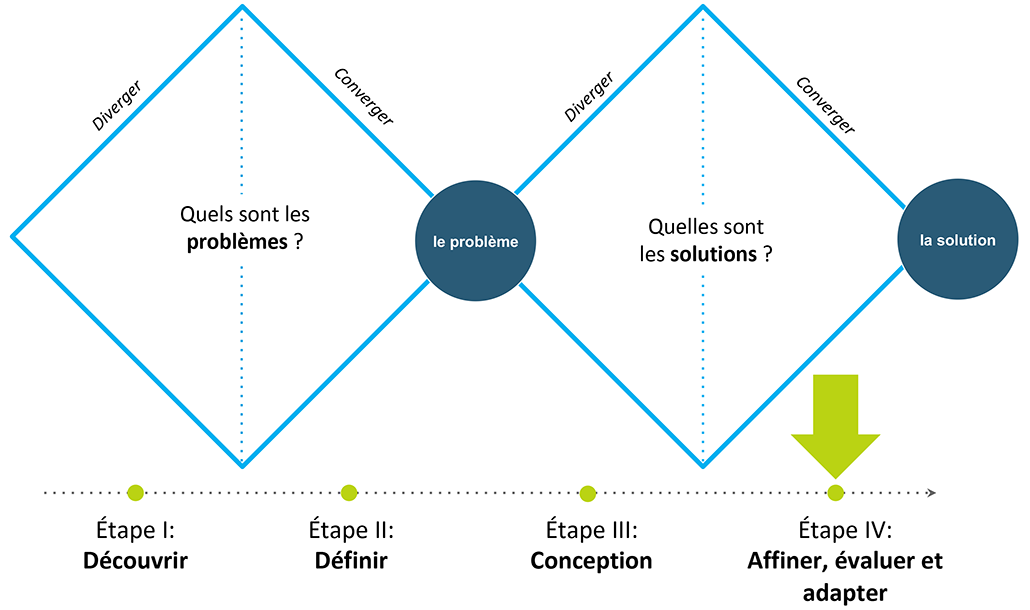
Dans une optique d’amélioration continue, le processus d’affinage et d’évaluation peut se poursuivre indéfiniment au fur et à mesure que les innovations se développent dans différents contextes. Qu’il s’agisse de tester, de piloter ou d’évaluer une solution dans un nouveau contexte ou un nouveau cadre, il est généralement nécessaire de recourir à un certain degré d’adaptation, que la solution ait ou non à l’origine été élaborée à l’aide de la méthode CCH.
Les principales parties prenantes au niveau local et les utilisateurs potentiels de la solution adaptée au nouveau contexte, à l’instar des acteurs à impliquer dans la co-conception (voir la session 5).
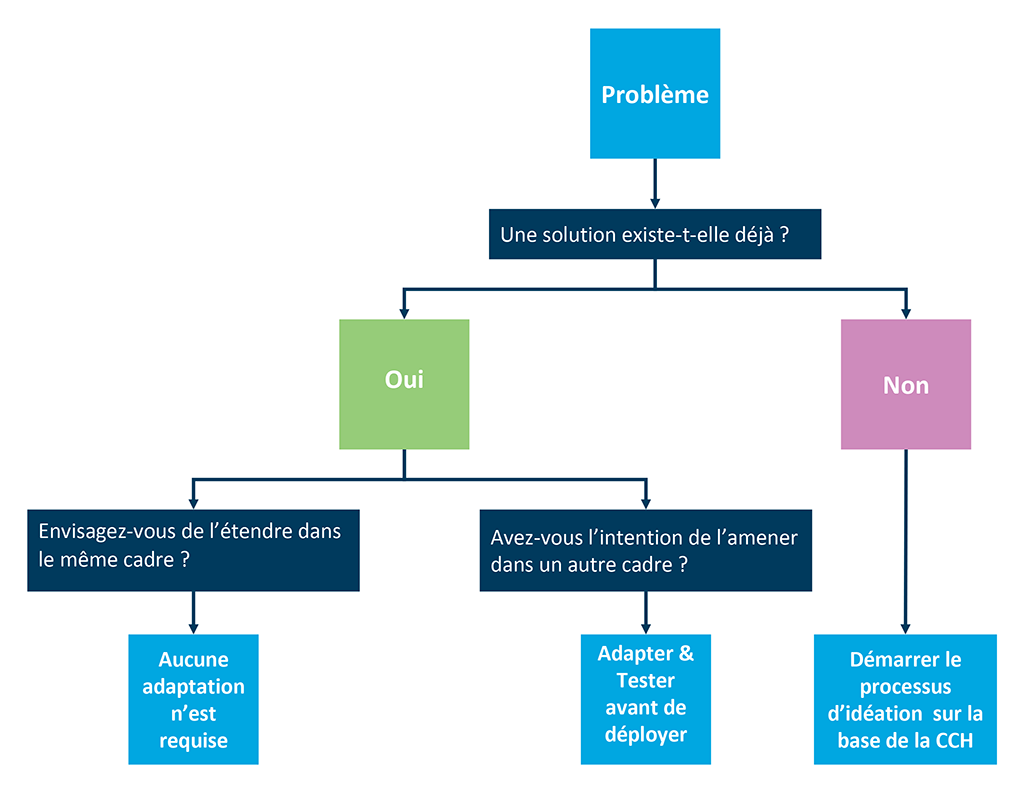
Le point de départ est généralement le même, qu’il s’agisse d’apporter la nouvelle solution générée grâce à la CCH ou d’une solution préexistante dans votre contexte :
Au Nigéria, nous avons réalisé une adaptation adjacente. En effet, nous avions l’intention d’adapter la solution choisie à une zone de santé différente, dans un pays différent, et nous avons compris qu’il était nécessaire de changer de format.
Certes, le fait de modifier quelque chose qui existe déjà peut ne pas sembler innovant ou intéressant, mais ce sont précisément ces types d’adaptation qui sont à l’origine de l’innovation ! L’on considère généralement que l’innovation consiste à créer quelque chose d’entièrement nouveau et révolutionnaire, ou qu’elle renvoie à ce que l’on appelle l’innovation transformationnelle. Cependant, ceci n’est pas la seule forme que peut prendre l’innovation :
Lorsque le moment est venu pour l’équipe de Breakthrough ACTION au Nigéria de générer des idées
(Idéation), l’équipe a décidé qu’en plus de générer des idées une nouvelle fois, elle examinerait également les solutions existantes en vue d’une possible adaptation. L’équipe s’est donc penchée sur le portefeuille de solutions offert par Breakthrough ACTION et s’est inspirée de Empathways, qui est un outil conçu pour renforcer l’empathie entre deux groupes de personnes dans un cadre 1 :1.
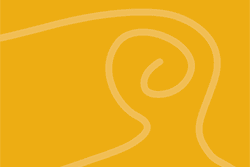
Le manque d’empathie de la part des prestataires de soins de santé est un problème bien connu. Empathways est une innovation créée par Breakthrough ACTION pour remédier à ce problème.
Empathways est une activité basée sur un jeu de cartes conçue pour accompagner les jeunes clients et leurs prestataires de services en planification familiale lors d’une expérience dynamique et stimulante qui passe par la prise de conscience, l’empathie et l’action. L’objectif est de susciter une profonde empathie entre ces groupes. Cette empathie sera ensuite utilisée par les prestataires pour améliorer leur offre de services en planification familiale pour les jeunes. (Breakthrough ACTION, n.d.).

Les recherches ont révélé un manque de compassion et d’empathie lors des séances de conseils et des consultations à domicile organisées par les ASC. L’équipe a donc décidé de se concentrer sur l’innovation pour susciter des comportements empreints d’empathie de la part des ASC et des comportements plus coopératifs de la part des gardiens(nes) d’enfants.
Empathways a été présenté comme une solution possible parce qu’il s’attaque au même problème fondamental : le manque d’empathie. Une fois que cette décision a été prise et qu’une solution existante a été identifiée aux fins d’adaptation, l’équipe a travaillé sur une série de questions, qui ont été consolidées, affinées et présentées sous forme de Canevas d’adaptation.
Inspiré du la matrice d’affaires, le Canevas d’adaptation est une fiche représentée sur une page qui a pour but d’aider les praticiens de la nutrition et du CSC à identifier et à mettre au point les changements nécessaires au moment d’adapter une solution.
Quelles sont les principales parties prenantes (public cible, personnes influentes, les systèmes en place, les organisations, les institutions, etc.) dans le contexte original ? S’agit-il des mêmes dans le nouveau contexte ou alors il y’en a d’autres ? Jouent-ils les mêmes rôles ou des rôles différents).
Astuce : Présenter les parties prenantes et les relations qu’elles entretiennent, selon le modèle socio-écologique.
Examinez les données ou les preuves existantes provenant du pays ou du contexte pour lequel vous effectuez cette adaptation. Quelles remarques vous en faites ? Envisagez un changement de cadre dans le nouveau contexte. S’agit-il d’un contexte urbain ou rural ? Quel est le profil socio-économique de la population cible ?
Quelles sont les ressources essentielles requises pour le concept original ? Sont-elles également nécessaires dans le nouveau contexte ?
Astuce : prenez en compte les cinq éléments clés énoncés par Zhang : le personnel, le matériel, l’espace, les systèmes, et le soutien social (Zhang 2021). Les ressources suivantes sont-elles identiques ou différentes dans ce nouveau contexte ? Quels sont les coûts associés ?
Quels changements essayez-vous d’opérer en adaptant ce concept ? La théorie du est-elle toujours valable ?
Astuce : Complétez cette phrase en remplissant les espaces vides : Si nous [NOM DE L’ACTIVITÉ] auprès de [AUDIENCE CIBLE], alors [RÉSULTAT SOUHAITÉ].
Quelles sont les contraintes présentes dans le nouveau contexte et susceptibles d’être prises en compte au moment d’adapter l’innovation ?
Astuces : Prenez ces facteurs en compte
mais ne vous y limitez pas.
Compte tenu des étapes précédentes, quels sont les principaux changements que vous proposez d’apporter au concept ?
Astuce : Dressez la liste des changements et classez-les par ordre de priorité à l’aide d’une matrice importance/ difficulté ou d’une autre matrice de votre choix. Par exemple, la traduction peut être classée comme « importante » et « pas difficile », alors que l’adaptation d’une vidéo numérique pour que les personnages ressemblent davantage à la population locale peut être classée comme « difficile ». L’importance peut être inconnue, mais peut éventuellement être validée lors des tests !
Quels sont les changements qui doivent être validés ? Comment saurez-vous si les changements sont opérés avec « succès » ? Qui comptez-vous associer à la validation, et comment comptez-vous vous y prendre ?
Astuce : Focalisez-vous sur l’évaluation de la souhaitabilité et de la faisabilité.
Chaque élément du canevas comprend des questions de suivi et des astuces permettant de déterminer les différentes approches d’adaptation possibles. Vous trouverez peut-être inutile de remplir toutes les différentes composantes, et ce n’est pas grave. Chaque solution, chaque adaptation et chaque contexte sont uniques.
Essayez de remplir la première ébauche du canevas assez rapidement (en moins d’une heure). Si vous le faites seul, partagez-le avec d’autres parties prenantes clés pour obtenir leur avis. Si vous avez la possibilité de remplir le canevas en équipe, organisez une séance individuelle de brainstorming pour chaque rubrique, partagez les résultats et évoluez sur la base des contributions de chacun.
Voici un exemple d’utilisation du canevas d’adaptation par l’équipe de Nourishing Connections.
À présent que les changements spécifiques ont été identifiés, il est temps de les transformer en prototype. Référez-vous à la session 5, Prototyper et Test, pour obtenir des directives spécifiques sur la construction d’un prototype.
| Composante | Version originale d’ Empathways | Version de l’outil Empathways adaptée au programme Nourishing Connections au Nigéria |
| Sujet | Version originale de l’outil Empathways | Version adaptée de l’outil Empathways |
| Séries ou catégories de cartes | – Ouverture d’esprit – Prise de conscience – Compréhension – Empathie – Compassion – Action | – Prise de conscience – Compréhension – Empathie – Compassion Les autres catégories ont été laissées de côté parce que le programme « Nourishing Connections » comporte d’autres activités qui permettent d’établir cette partie de la relation. |
| Audience | Les prestataires de services en planification familiale et les jeunes | Les ASC et les gardiens(nes) d’enfants âgés de 6 à 24 mois |
| Format | Jeu de cartes | Fiche d’une page contenant 5 questions |
| Méthode | Interaction individuelle | Interaction individuelle |
| Comment l’utiliser | À utiliser lors des séances de formation | À utiliser lors des séances de conseils |
| Singularité | Première mise en pratique dans un espace sécurisé/un cadre de formation. | Le concept « Partagez juste ce qu’il faut » : Les ASC doivent partager avec les gardiens d’enfants juste ce qu’il faut afin de ne pas s’exposer. |
Téléchargez le prototype Empathways sur la Nutrition qui a été testé au Nigeria. Voir la session 5 pour plus de détails sur le test du prototype au Nigéria.
Une fois les tests achevés et les résultats synthétisés, une version du prototype Empathways sur la Nutrition a été finalisée afin d’être utilisée dans le contexte du Nigéria. Elle comprend un outil d’une page composé de cinq questions et divisées en plusieurs rubriques, allant de l’établissement de la relation à l’état émotionnel de la mère. La version finale de l’outil Empathways sur la Nutrition a été intégrée à d’autres activités du programme Nourishing Connections, faisant ainsi de cet outil une composante d’un processus plus grand. Vous trouverez l’outil Empathways sur la Nutrition aux pages 3 et 4 des Matériel de travail des ASC.
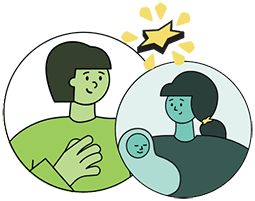

Merci d’avoir suivi la cinquième leçon de l’ouvrage Mettre en pratique la conception centrée sur l’humain pour l’amélioration des programmes de nutrition. Vous trouverez ci-dessous un questionnaire non noté qui vous permettra de vérifier votre compréhension de de la session 5. Cliquez sur le bouton « Contrôle des connaissances » pour commencer.
Dès lors que vous avez identifié les prototypes, vous devez les mettre à la disposition des utilisateurs afin d’évaluer leurs fonctionnalités et leurs performances, et de mesurer l’expérience utilisateur. Ceci vous permettra de déterminer si le prototype doit être davantage développé ou abandonné.
Un test de sprint est une série de tests réalisés suivant un niveau de fidélité spécifique, en fonction de ce que l’équipe de conception cherche à apprendre.
Retournez chaque carte pour découvrir ce qu’il y’a à apprendre à chaque étape du processus.
Validation du concept/désirabilité, identification des premiers problèmes et proposition de valeur.
Utilisabilité, viabilité du flux d’utilisateurs, fonctionnalités, interface, modèles d’interaction, navigation et communication avec les parties prenantes.
Mise à échelle, conception visuelle, branding ou image de marque, affinage de la proposition de valeur, améliorations de l’utilisabilité, et fonctionnalités.
Gardez à l’esprit que si vous ne disposez pas des ressources nécessaires pour réaliser toutes les étapes, il conviendra de vérifier les leçons apprises les plus importantes pour votre équipe et vous concentrer sur l’une des phases.
L’itération désigne le fait d’apporter des améliorations progressives aux prototypes sur la base du feedback obtenu lors des tests. L’itération peut être réalisée au cours d’une seule série de tests, et elle est toujours réalisée entre les différentes séries de tests (c’est-à-dire que lorsque vous passez des tests de basse fidélité à des tests moyenne fidélité, vos prototypes évoluent en fonction de ce que vous avez appris).
Par exemple, imaginez que vous testiez un prototype dans un forum communautaire qui exige que les utilisateurs fassent acte de présence, mais qu’aucun utilisateur ne se présente. Le jour suivant, vous changez de lieu et testez le prototype dans les domiciles pendant les consultations effectuées par les ASC, et vous atteignez l’objectif fixé. Il s’agit là d’un exemple simple de test itératif où vous apportez des modifications au fur et à mesure sur la base du feedback reçu en temps réel. Cela peut se faire au cours d’une série de tests, et cela se fait avec certitude d’une série de tests à une autre.
Il est enfin temps de tester vos prototypes ! C’est une étape passionnante du processus de conception, car c’est la première fois que vous obtiendrez un feedback réel sur vos prototypes. À ce stade, votre état d’esprit est plus que jamais déterminant.
Il peut s’avérer difficile pour vous de rester déconnecté de « vos » idées de prototypes, mais il est essentiel de le faire lors de la phase de test. Il est tout à fait normal de vouloir que les prototypes satisfassent aux attentes, mais pour y parvenir, nous devons souvent commencer par identifier ce qui ne fonctionne pas. N’oubliez pas que l’objectif du prototypage est de battre en brèche votre idée, et non de la valider. C’est l’un des moments où l’échec est véritablement synonyme de succès. Chaque leçon apprise est importante, et si l’un des prototypes ne fonctionne pas, il convient de le découvrir le plus tôt possible afin de pouvoir l’adapter ou l’éliminer complètement. Le feedback le plus important est celui des utilisateurs finaux et si le prototype ne fonctionne pas pour eux, il faudra l’accepter ainsi.
Gardez l’esprit d’expérimentation d’Edison au cœur de votre prototypage et de vos tests.
« Je n’ai pas échoué. J’ai juste trouvé 10 000 façons de faire qui ne fonctionneront pas. »
– Thomas A. Edison
En général, les tests sont effectués immédiatement après la réalisation des prototypes, et ceci dans le cadre d’une phase spécifique. Dans un contexte de basse fidélité, vous pourriez disposer idéalement de 4 à 5 jours pour tester vos prototypes et obtenir des résultats significatifs, même s’il est également souhaitable de procéder à ces tests en peu de temps.
Passez en revue cette liste de contrôle des tests afin de vous assurer que les membres de votre équipe et vous, disposez d’une compréhension claire et commune de ce qui doit être fait pour chaque prototype en prélude aux tests.
Il existe une variété d’indicateurs qui peuvent être utilisés au cours de chaque phase. Il est essentiel que les membres de votre équipe s’entendent sur ce qu’ils souhaitent apprendre. Utilisez ces exemples d’indicateurs pour déterminer, au cours de chaque série de tests si vos prototypes fonctionnent ou non.
| Désirabilité | Faisabilité | Mise à l’échelle |
| Déterminée par les préférences des utilisateurs | Déterminée par des contraintes internes, programmatiques | Déterminée par des facteurs contextuels et des partenariats |
| Indicateurs (facteurs qui augurent l’adoption) | Indicateurs (facteurs qui augurent une opérationnalisation efficace) | Indicateurs (Facteurs qui augurent la reproductibilité avec le même niveau de succès) |
| Avantage relatif Dans quelle mesure innove-t-elle par rapport aux pratiques actuelles ou précédentes ? Si l’innovation est perçue comme un changement extrême, elle ne sera pas compatible avec les expériences passées et aura moins de chances d’être adoptée. | Risque et positionnement À l’aide de la matrice des risques/du portefeuille d’innovations, dans quelle mesure cette innovation est-elle similaire à ce qui a été fait précédemment dans le cadre du programme PSI/ DFID ? Dans quelle mesure, par conséquent, présente-t-elle un risque en termes de retour sur investissement ? | Réplicabilité Dans quelle mesure cette innovation peut-elle être répliquée efficacement dans d’autres contextes ? |
| Essayabilité Dans quelle mesure l’utilisateur peut-il tester ou mettre en pratique le nouveau comportement avant de l’adopter ? | Faisabilité technique Dans quelle mesure l’innovation peut-elle être réalisée efficacement au moyen des ressources disponibles pour le programme ? | Plaidoyer À quel point notons-nous déjà des signes chez les utilisateurs qui encouragent, découragent ou révèlent de la passivité face à cette innovation ? |
| Observabilité Dans quelle mesure les résultats (le changement) de l’innovation sont-ils visibles pour les autres ? Si les effets observés sont perçus comme étant faibles ou inexistants, la probabilité d’adoption est réduite. | Faisabilité logistique Dans quelle mesure l’innovation peut-elle être mise en œuvre efficacement au moyen des ressources disponibles pour le programme ? | |
| Simplicité Dans quelle mesure l’innovation est-elle perçue comme relativement facile à comprendre et à utiliser ? Les innovations perçues comme complexes ont moins de chances d’être adoptées. | Faisabilité financière Dans quelle mesure l’innovation est-elle financièrement réalisable dans les limites des ressources du programme ? | Viabilité financière à long terme L’innovation doit-elle être soutenue financièrement ? Dans quelle mesure disposons-nous d’un plan pour la mise en place d’un mécanisme autonome à cet effet ? |
| Plus-value (pour l’utilisateur) Dans quelle mesure cette innovation apporte-t-elle de la simplicité, de l’efficience, de l’efficacité ou de la pertinence pour l’utilisateur ? | ||
| Plus-value (pour la structure de santé/le personnel) Dans quelle mesure apporte-t-elle de la simplicité, l’efficience, l’efficacité ou du sens à la structure de santé et/ou au personnel ? | Validité scientifique Dans quelle mesure l’innovation peut-elle induire directement le changement de comportement souhaité ? | Préparation Dans quelle mesure l’innovation est-elle adaptée à un marché ou à une plus grande base d’utilisateurs ? |
| Volonté de payer (le cas échéant) Dans quelle mesure l’utilisateur est-il prêt à payer pour s’offrir ce produit, ce service ou cette offre ? |
Breakthrough ACTION en collaboration avec le programme Advancing Nutrition de l’USAID, a testé une série de prototypes auprès de trois différents types de publics : Les agents de santé communautaire, les gardien(nes) d’enfants et les personnes influentes au sein de la famille (partenaires, sages-femmes, belles-mères et leaders de la communauté). L’équipe a pu évaluer à quel point les prototypes peuvent aider chaque type de public à atteindre des objectifs spécifiques.
Avant de commencer nos tests, nous avons créé un canevas dans lequel nous avons défini les objectifs à atteindre auprès de chaque type de public. En conséquence, nos prototypes ont favorisé l’émergence des comportements décrits dans le schéma ci-dessous.

Les outils me permettent de : Gagner de la confiance, comprendre et répondre aux besoins des mères en ce qui concerne le fait de : Diversifier l’alimentation des enfants à partir de 6 mois.
Les outils me permettent de : Acquérir des connaissances sur ; mieux communiquer mes besoins sur ; développer le pouvoir de décision pour offrir : La diversification de l’alimentation de l’enfant dès l’âge de 6 mois.
Les outils me permettent de : Autonomiser, motiver et créer un environnement favorable qui encourage les ASC à aider les mères à : Diversifier l’alimentation de l’enfant dès l’âge de 6 mois.
Il existe une grande variété de méthodes de tests permettant d’évaluer l’interaction des utilisateurs avec vos prototypes. Parmi les méthodes les plus couramment utilisées, citons : la simulation, l’environnement réel, groupes de discussion et test individuel. Cliquez sur chaque méthode pour obtenir une description et des exemples.
Un test par simulation ne se limite pas à parler du processus, mais il requiert la réalisation pratique du scénario par les membres de l’équipe.
Quels sont les acteurs impliqués ?
Une séance de conseils est simulée à l’aide du prototype pour permettre de découvrir comment un(e) gardien(ne) d’enfant pourrait réagir au nouveau contenu ou à la nouvelle approche.
Prototypes de Nourishing Connections testés au moyen de cette méthode :
Formats possibles :
Exposer le(s) utilisateur(s) au prototype dans l’environnement réel où la solution finale sera utilisée.
Quels sont les acteurs à impliquer ?
Durée : 60 minutes minimum
Introduire le prototype dans le travail quotidien des agents de santé communautaire, qui pourraient l’utiliser à l’avenir à l’intention des gardien(nes) d’enfants ou des familles, dans un environnement réel.
Prototypes de Nourishing Connections testés au moyen de cette méthode :
Formats possibles :
Cette méthode est utilisée pour démontrer comment le prototype devrait fonctionner et recueillir les perceptions, les réactions et les suggestions des utilisateurs.
Quels sont les acteurs à impliquer ?
Durée : 30 minutes minimum
Cette méthode est généralement utile pour tester des solutions en matière de politique, une nouvelle stratégie ou un nouveau processus.
Cette méthode n’a pas été utilisée dans le cadre du projet Nourishing Connections, mais elle mérite néanmoins d’être mentionnée.
Formats possibles :
Avec cette méthode, le prototype est présenté à un individu dans le cadre d’une session contrôlée, et il peut ainsi être exposé à ce prototype.
Qui sont les acteurs à impliquer ?
Durée : 60 minutes minimum
Prototypes de Nourishing Connections testés au moyen de cette méthode :
Les utilisateurs ont été exposés au prototype de façon individuelle et leur feedback a été recueilli afin d’orienter les modifications à apporter à ce prototype.
Formats possibles :
Lors de la réalisation d’une série de tests, qu’ils soient des tests basse fidélité, moyenne fidélité ou haute fidélité, testez chaque prototype plusieurs fois jusqu’à ce que vous commenciez à constater une saturation ou que vous n’appreniez plus de nouvelles informations à chaque nouveau test. Même s’il n’existe pas de nombre défini pour les tests, essayez d’effectuer trois tests pour chaque prototype afin de commencer à développer une tendance. Il est recommandé de procéder à des itérations entre chaque test !
La CCH utilise principalement des méthodes qualitatives pour collecter, analyser et évaluer systématiquement les données, bien que des méthodes quantitatives puissent également être utilisées. Vous trouverez ci-dessous des méthodes de collecte de données couramment utilisées. Les méthodes doivent être sélectionnées en fonction des conditions réelles du test. Les méthodes les plus courantes sont les suivantes : réflexion à haute voix, l’entrevue post-consultation ou entrevue de sortie, l’observation et taux de recommandation net. Cliquez sur chaque méthode pour en savoir plus.
Il s’agir d’une méthode par laquelle les participants travaillent en suivant le flux d’une expérience spécifique (qui peut être numérique), tout en décrivant verbalement ce qu’ils font et ce qu’ils attendent de chaque action qu’ils entreprennent.
Cette méthode a été utilisée dans le cadre des tests effectués au Nigéria, conjointement avec le test individuel et les discussions de groupe. Cela a permis à l’équipe d’améliorer l’utilisabilité des prototypes après chaque session avant de poursuivre les tests.
Dans le cadre de cette méthode, les utilisateurs ou les groupes d’utilisateurs sont interrogés à la fin de leur expérience dans le but de recueillir leurs perceptions, leurs comportements, leurs sentiments et leurs suggestions.
Cette méthode a été utilisée pour tester tous les prototypes au Nigéria, car elle permet à l’équipe de recueillir immédiatement les commentaires de l’utilisateur.
Selon cette méthode, la personne qui réalise le test observe et documente les interactions de l’utilisateur avec le prototype afin d’identifier les implications en termes de souhaitabilité, de faisabilité et de mise à l’échelle. Il ne s’agit pas de poser directement des questions aux utilisateurs, mais de prêter une attention particulière à ce qui s’est passé pendant le test, puis d’interpréter objectivement les résultats de ces observations.
La méthode par observation a également été utilisée lors de l’expérience au Nigéria, conjointement avec la simulation et l’environnement réel. Cela a permis à l’équipe de collecter des données sans interrompre l’expérience des utilisateurs.
Selon cette méthode, l’utilisateur répond à des questions de nature quantitative sans l’intervention de l’administrateur du test. Par exemple, « Sur une échelle de 1 à 5, 5 étant le plus probable, quelle est la probabilité que vous recommandiez ce produit à un ami ou à un membre de votre famille ? »
Cette méthode peut être utilisée conjointement avec la méthode post-expérience, car elle constitue un moyen rapide et facile d’atteindre le même objectif.
| Ce qu’il faut faire | Ce qu’il faut éviter |
| Demandez-leur de « réfléchir à haute voix » Par exemple, s’ils lisent votre contenu, demandez-leur ce qu’ils pensent de ce qu’ils sont en train de lire. | Éviter de leur demander leurs avis « Aimez-vous mon prototype ? » « Pensez-vous que c’est une bonne idée de créer une application ? » |
| Demandez-leur ce qu’ils feraient « Que feriez-vous pour trouver XX sur ce site internet ? » | |
| Demandez-leur ce qu’ils ressentent « Si vous voyiez une application de ce type, que ressentiriez-vous ? » | |
| Posez des questions ouvertes « Comment réagiriez-vous à cette page ? » « Dans cette rubrique, vous avez trois options ; sur quelle option allez-vous cliquer ? » | Éviter de poser des questions suggestives « Y a-t-il quelque chose qui manque dans cette étape ? » |
| Éviter les hypothèses « Pourriez-vous acheter cette application ? » | |
| Éviter de leur demander la solution « Comment pourriez- vous concevoir ceci ? » | |
| Observez leurs réactions | Ne vous fiez pas à ce qu’ils disent |
| Demandez-leur pourquoi « Vous dites être confus à ce niveau, pourquoi ? » | Éviter de répondre à leurs questions « L’objectif de cette section sur l’Application est de…. » |
N’oubliez pas de vous documenter, de vous documenter encore, et de toujours vous documenter ! Prenez des notes et des photos, avec l’autorisation de l’intéressé bien sûr. Servez-vous de cet outil de synthèse quotidienne pour faire une synthèse de vos résultats au quotidien.
Le processus d’évaluation de la CCH est continu et permet d’améliorer le prototype tout au long de la phase de test ou des séries de tests. Voici les étapes générales de l’évaluation continue qui facilitent l’itération tout au long du processus.
À la fin de chaque journée de test des prototypes, prenez 30 à 60 minutes pour discuter des résultats avec votre équipe. Cette réunion vous permettra d’analyser rapidement les résultats des tests, notamment de partager les observations, les impressions sur ce qui a fonctionné et ce qui n’a pas fonctionné, et de recueillir les recommandations du groupe pour itérer et adapter les prototypes afin de les améliorer. Utilisez cet outil de synthèse quotidienne pour réaliser vos débriefings quotidiens plus facilement.
Il s’agit de la session finale au cours de laquelle les leçons apprises par l’équipe seront analysés afin de formuler une recommandation finale au sujet de la solution.

À la fin de cette session, vous serez capable de :
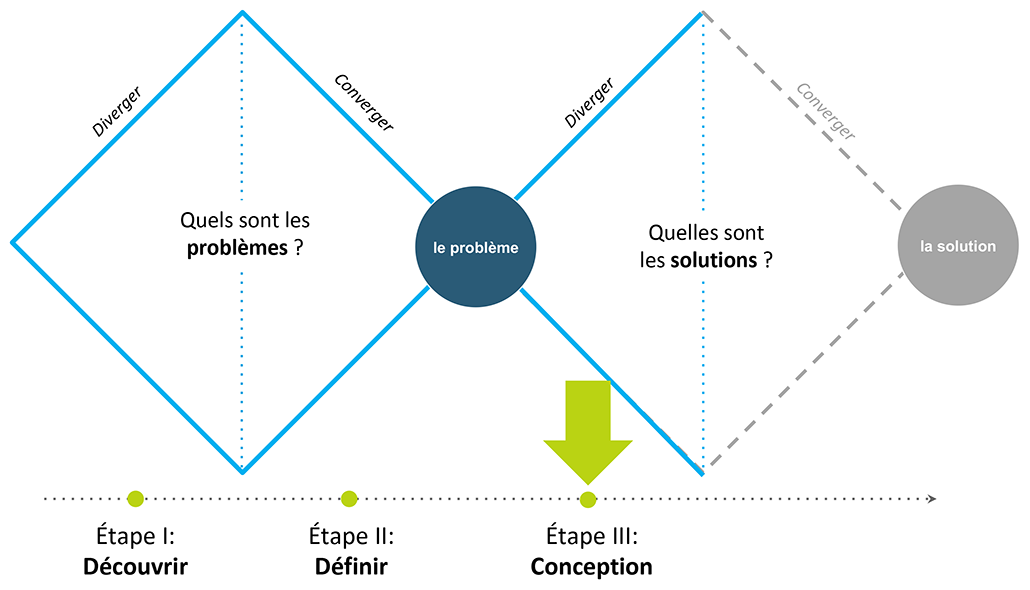
Pour atteindre la deuxième partie de la phase de conception, vous devez disposer de 4 à 6 concepts prêts à être transformés en prototypes. Ces prototypes seront ensuite testés auprès des utilisateurs.
À ce stade, vous devez impliquer l’équipe principale de conception et le public/utilisateurs auprès duquel/desquels sont réalisés les tests (personnes auprès desquelles vous comptez administrer le test).
Un prototype est un modèle expérimental d’une idée. C’est un moyen de donner à nos idées une certaine forme visible que nous pouvons présenter à quelqu’un d’autre pour voir si notre idée apporte une valeur ajoutée.
Rappelons qu’au cours de la Session 1, la CCH nous a permis de trouver des solutions désirables, faisables et extensibles. Le prototypage est cette pratique spécifique qui nous aide à construire, tester et itérer des solutions qui répondent à ces trois critères. Retournez chaque carte pour en savoir plus sur chaque critère.
Est-il probable que le groupe cible l’adopte ?
Comment l’opérationnaliser de la manière la plus efficace et la plus efficiente possible ?
Comment pourrions-nous nous assurer que la solution puisse être facilement répliquée ?
Combiens d’utilisateurs finaux nos solutions peuvent-elles atteindre ?
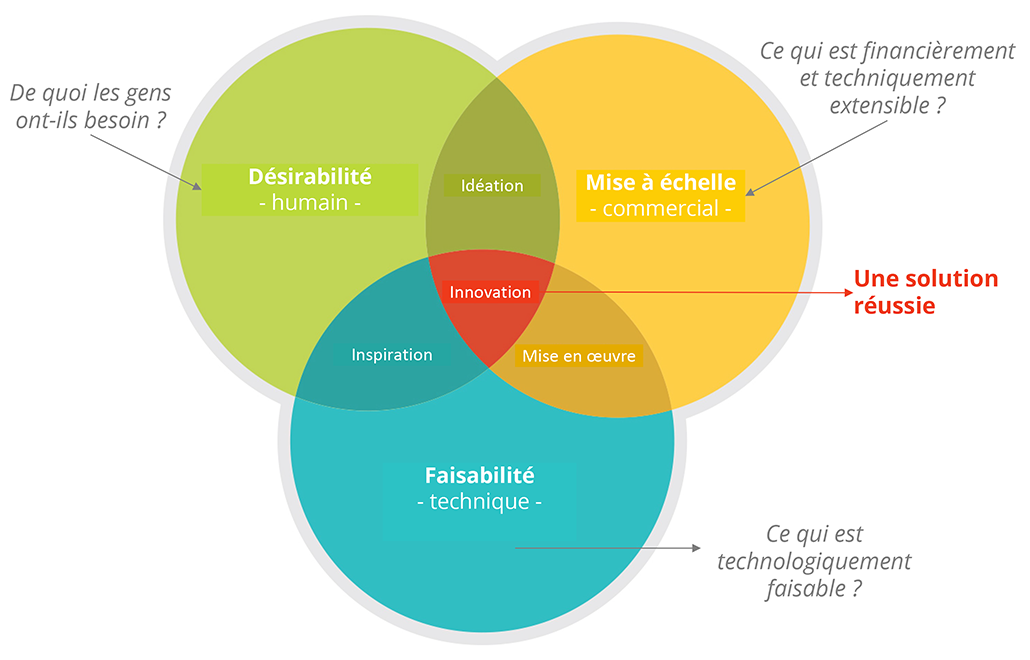
Le prototypage consiste à donner vie à des idées en un laps de temps. Il nous permet d’expérimenter nos idées et nos concepts, de les tester, d’en apprendre et de les améliorer de manière peu coûteuse et peu risquée. Lorsque vous réfléchissez à la manière de créer un prototype, posez- vous la question suivante : « Comment puis-je amener les gens à interagir avec mon concept le plus rapidement possible ? »
Les prototypes peuvent prendre de nombreuses formes différentes les unes des autres. La liste suivante n’est donc pas exhaustive. Néanmoins, il convient d’explorer chaque option pour savoir quel prototype pourrait le mieux répondre au besoin de conception.
Essayer d’abord d’en créer un avec des matériaux bon marché.
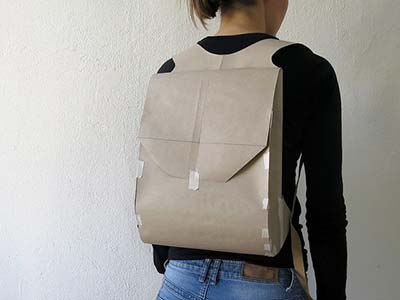
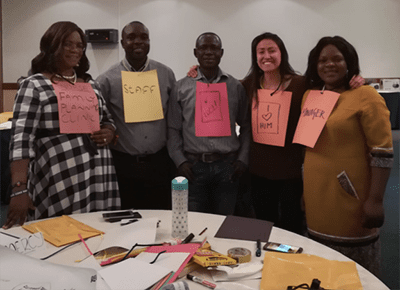
Créer un scénario que les utilisateurs peuvent jouer pour tester l’expérience que vous essayez de créer…
…dessinez le scénario sous forme de scénarimage.
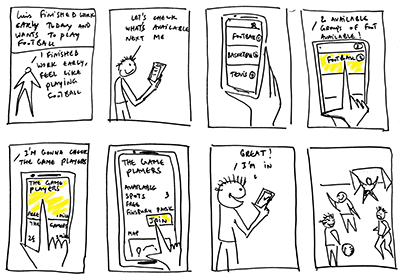
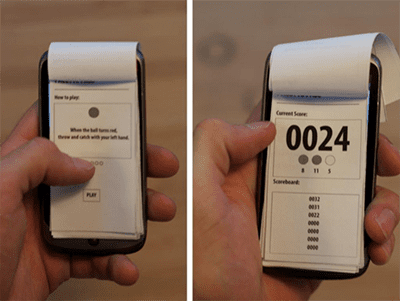
Utilisez des croquis pour présenter une maquette de votre concept.
Réalisez une maquette de votre espace qui reflète le flux, l’orientation et l’espacement.
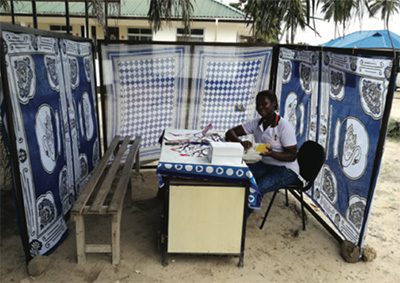
Avant de construire votre prototype, collaborez avec votre équipe principale de conception afin de remplir le Canevas de prototype. Cela vous permettra de clarifier les principaux aspects de votre concept, notamment ce qu’il est censé apporter comme solution, les hypothèses que vous allez tester, l’aspect qu’il aura, etc. Il est préférable de remplir ce canevas au sein des petits groupes.
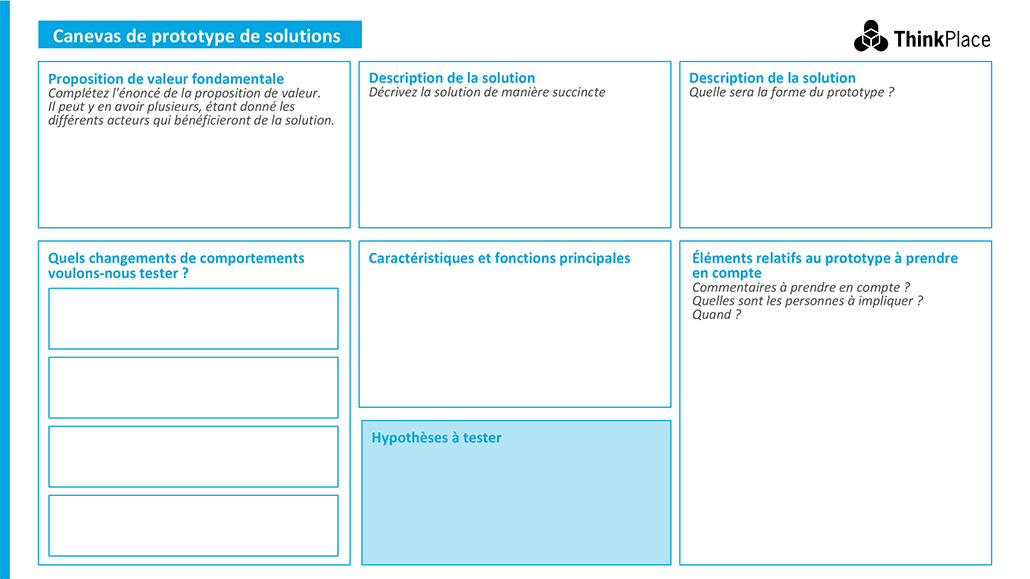
En général, les prototypes doivent être réalisés rapidement et à un coût relativement faible, à l’aide de matériaux auxquels on peut facilement avoir accès. Pensez à un projet d’artisanat que vous avez réalisé à l’école primaire. Quels matériaux avez-vous utilisés ? Il s’agit- là du type de matériaux dont vous aurez besoin ici. Par exemple, du papier, des boîtes en carton, du tissu, des marqueurs, du ruban adhésif, des bouteilles d’eau vides, des tableaux d’affichage, des magazines, de la pâte à modeler… Vous avez saisi l’idée. Réfléchissez-y : de quel type de matériaux pouvez-vous vous procurer facilement ? Quels matériaux pouvez-vous obtenir à moindre coût ?
Le processus général est le suivant : créer, valider, itérer, and revalider. Retournez chaque carte pour voir une définition.
Réaliser un prototype à partir d’une idée ou d’un concept.
Tester et obtenez le feedback des utilisateurs pour savoir s’ils pensent que le prototype apportera satisfaction.
Affiner et adapter le prototype en fonction du feedback des utilisateurs, par des modifications et le remplacement des éléments qui ne fonctionnent pas.
Après avoir intégré les changements : Le prototype permet-il d’obtenir les résultats escomptés ? Est-il facile à utiliser ? Peut-il fonctionner dans des contextes différents ?
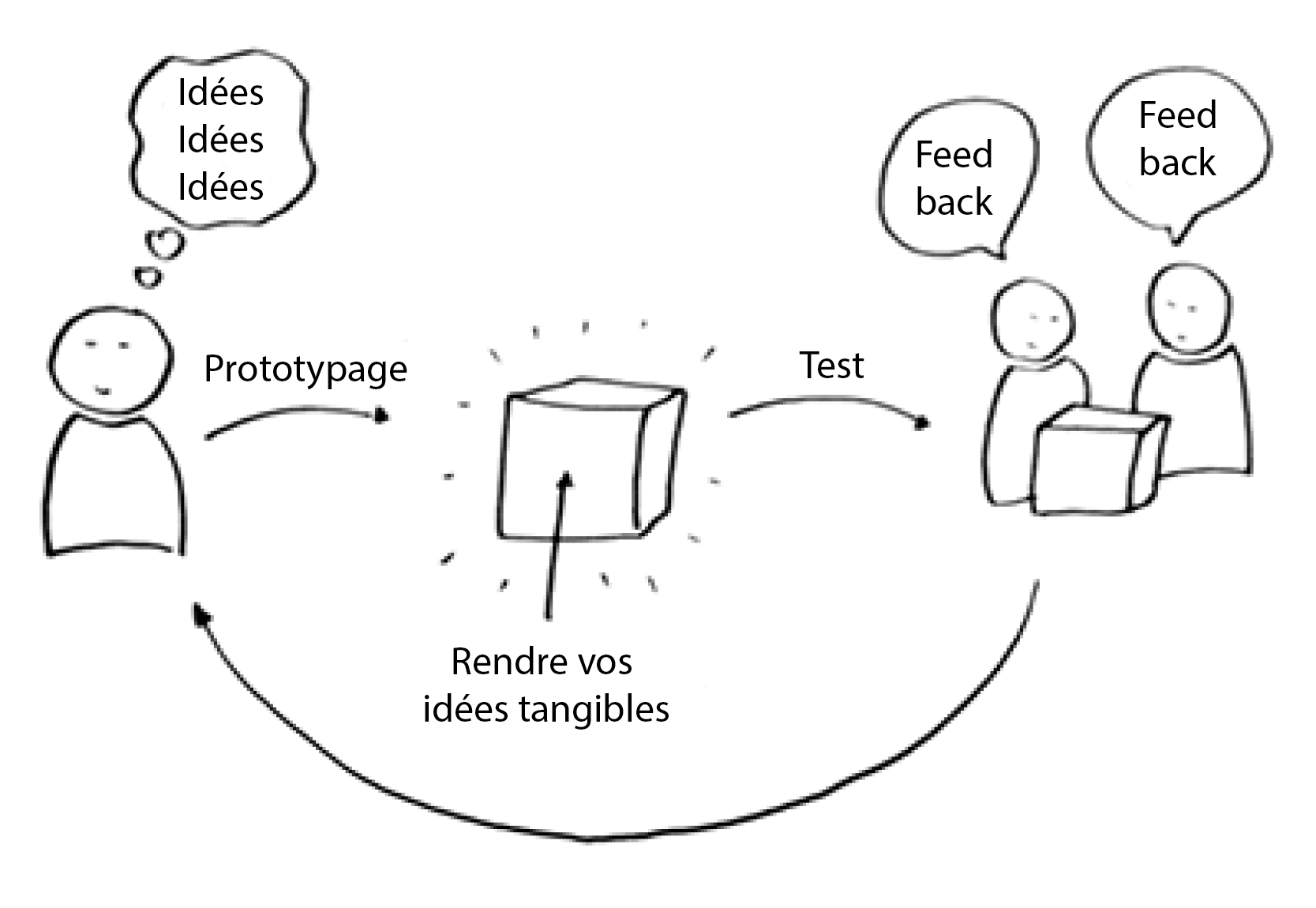
Le processus de prototypage peut être itéré avec le même niveau de complexité, ou niveau de fidélité, ou à travers différents niveaux de complexité ou niveaux de fidélité. La fidélité d’un prototype fait référence à son niveau d’exhaustivité, à son caractère détaillé et aux différentes phases de test. Le degré d’exhaustivité des prototypes dépend des stades de fidélité, qui sont basse, moyenne et haute. Retournez chaque carte pour en savoir plus.

Peu coûteux, approximatif et rapide à construire
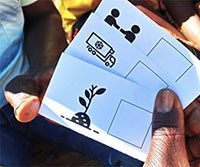
Légèrement plus détaillé, encore approximatif, mais se rapproche davantage de la solution
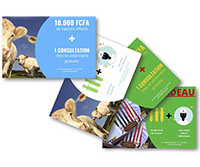
Beaucoup plus proche de la version finale, très détaillé et chronophage
Comme vous pouvez l’imaginer, l’aspect des prototypes diffère généralement dans chaque type de projet. Ne vous attendez donc pas à ce que vos prototypes ressemblent exactement à ces exemples. L’important est qu’ils soient tangibles et qu’ils permettent aux utilisateurs d’interagir avec eux.
En fonction de votre projet, vous pourrez peut-être effectuer plusieurs séries de tests à différents stades du niveau de fidélité.
Au Nigéria, huit prototypes ont été réalisés pour répondre aux six défis identifiés au cours de la phase de recherche formative. Voici les défis et les prototypes correspondants. (Des liens vers chaque prototype de Nourishing Connections sont disponibles sous l’onglet Matériels en haut de cette leçon). Cliquez sur chaque défi pour voir le(s) prototype(s) utilisé(s) pour le relever.
Votre propre aventure est un prototype inspiré des histoires et des jeux du type Choisir votre propre aventure. Dans cette version, les clients choisissent les options qui représentent le mieux leurs expériences passées, de sorte qu’à la fin du jeu, l’agent de santé communautaire peut déterminer à quelle étape du changement de comportement le client se trouve : l’étape de la connaissance, de l’attitude ou de la pratique.
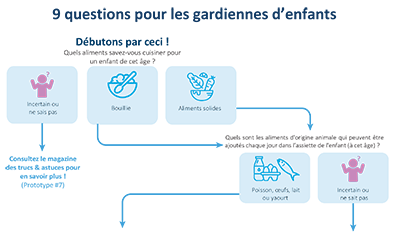
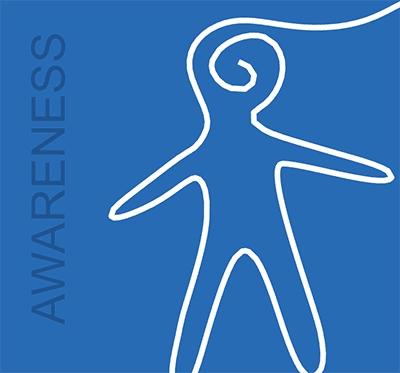
Empathways amène les ASC et les utilisateurs à réfléchir à leurs propres expériences et besoins, et à comprendre les besoins réels des utilisateurs. La solution est un jeu de cartes composé de 4 catégories de QUESTIONS et de TACTIQUES.
Le jeu de planification des repas est un jeu de cartes qui éduque les joueurs sur les repas 4 étoiles. Chaque carte présente l’image d’un aliment disponible au sein de la localité et qui appartient à une catégorie spécifique, ainsi qu’une icône indiquant la catégorie à laquelle il appartient. L’objectif du jeu est de permettre aux joueurs de créer des repas 4 étoiles pour garantir une alimentation complémentaire à partir des cartes, grâce à la combinaison des cartes de chacune des quatre catégories d’aliments disponibles. (Prototype en anglais.)
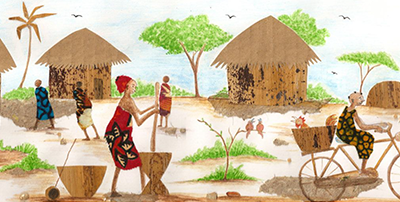
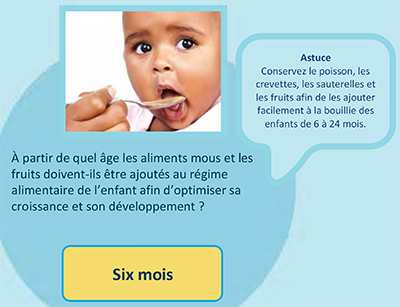
Le jeu-questionnaire est un jeu de questions-réponses similaire au jeu de société Trivial Pursuit. Les questions portent sur les faits et les mythes relatifs à la nutrition, ainsi que sur les facteurs qui favorisent ou entravent la diversification alimentaire et l’alimentation complémentaire. (Prototype en anglais.)
L’élimination des hypothèses est un guide simplifié utile pour les séances de conseils, qui permet de renforcer l’empathie lors du processus de conseils et de le rendre plus efficace dans l’identification des causes réelles de certains comportements. (Prototype en anglais.)
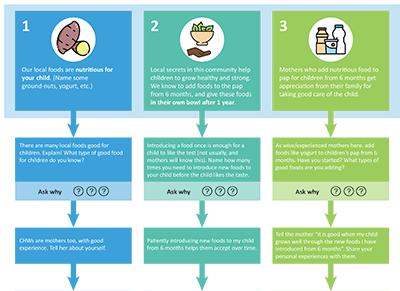
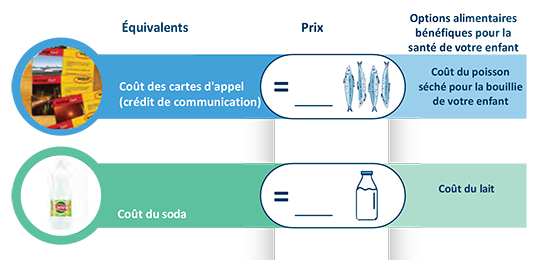
La comparaison des prix est un tableau visuel utilisé par les ASC pour comparer les prix des aliments bénéfiques pour la santé avec les prix des autres produits, ainsi que le temps de préparation des repas bénéfiques pour la santé par rapport au temps de préparation des repas non recommandés. (Prototype en anglais.)

La brochure de trucs et astuces est un manuel de recettes culinaires entièrement illustré qui contient trois recettes nigérianes bénéfiques pour la santé, cuisinées à l’aide d’aliments peu coûteux, disponibles au sein de la localité et très accessibles pour la majorité de la population ; ce manuel propose également des repas 4 étoiles afin d’encourager une alimentation complémentaire nutritive. (Prototype en anglais.)
Le planificateur de repas hebdomadaires est un outil de planification de repas utile pour la famille. Cet outil s’appuie sur les aliments dont dispose la famille. Par ailleurs, il comporte une rubrique spécialement consacrée à l’alimentation complémentaire des nourrissons et des jeunes enfants et une autre rubrique consacrée à l’alimentation du reste des membres de la famille. (Prototype en anglais.)
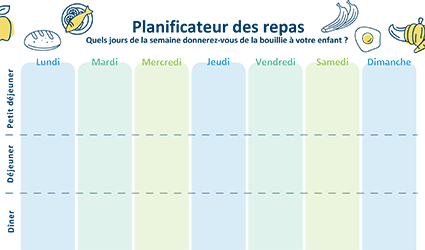
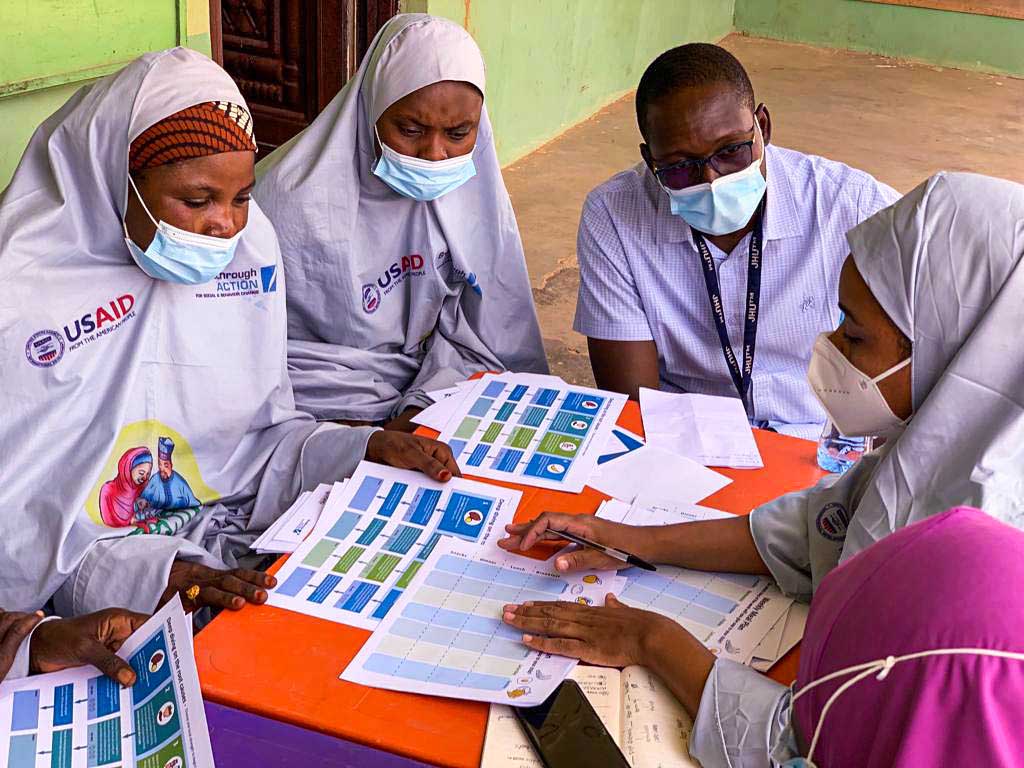
À la fin de cette session, vous serez capable de :

Vous avez achevé le premier niveau du cadre double diamant – félicitations ! À présent, il est temps de s’engager davantage dans la pensée divergente avec le démarrage de la première partie de la phase de conception, qui comprend la co-conception et l’idéation.
À ce stade, vous devez impliquer l’équipe principale de conception et les parties prenantes supplémentaires impliquées par vos idées et questions de type « Comment pourrions-nous » (questions CPN).
Comme l’indique la Session 1, la co-conception est une approche de conception qui permet de prendre activement en compte les perspectives multiples et diverses dans le processus de conception afin que le résultat final réponde aux besoins des utilisateurs. Il s’agit de rassembler ces perspectives variées pour bâtir un environnement souhaitable et réalisable pour les principales parties prenantes, et susceptible d’être mis à échelle.
De manière générale, un ingénieur, un chef de produit ou d’entreprise peut mûrir son produit ou son idée pendant de longues heures avant de le présenter aux utilisateurs. Si une fois lancé le produit ne fonctionne pas, il est généralement trop tard, trop épuisant ou trop coûteux d’y apporter des modifications, et la solution meurt.
L’objectif de la co-conception vise à éviter ce cas de figure, grâce à la conception de solutions qui permettent l’équilibre de tous les points de vue en collaboration avec les utilisateurs et d’autres parties prenantes clés. Même si le point de vue des utilisateurs est central, il doit être contrebalancée par le savoir-faire des autres membres de l’équipe de conception de base. C’est en travaillant ensemble que l’équipe pourra parvenir à une solution souhaitable, réalisable et susceptible d’être mise à échelle.
La première étape consiste à identifier les principales parties prenantes susceptibles d’être impliquées. Les parties prenantes ci-dessous ont été impliquées dans la co-conception du projet Nourishing Connections :
Une fois les co-concepteurs identifiés, il est question de les réunir pour conduire l’idéation.
« Les idées sont des premières réflexions. Elles manquent de précisions. Elles n’ont pas besoin d’être raisonnables ou réalisables. Elles doivent franchir le mur de la pertinence de la raison. »
– ThinkPlace Global Institute of Regenerative Design & Terry, 2022
L’idéation est le processus de génération de nouvelles idées. Il s’agit d’une réflexion rapide et divergente qui s’appuie sur les résultats de la recherche.
« La clé de l’idéation est de viser la quantité plutôt que la qualité ou la faisabilité des informations, et d’être ouvert aux idées de tous les intervenants sans tenir compte de leur position sociale. Il n’y a pas de discussion sur la qualité ou la faisabilité d’une idée, juste des suggestions complémentaires. »
– Breakthrough ACTION, n.d.
Le nombre idéal se situe entre 20 et 25 participants, qui peuvent ensuite former 4 à 5 groupes composés de 4 à 5 personnes.
Le processus d’idéation suit un schéma général de divergence et de convergence ci- dessous :
Cliquez sur chaque étape pour en savoir plus
Cette étape est axée sur les fiches de travail Présentation/« Comment pourrions- nous » de la Session 3.
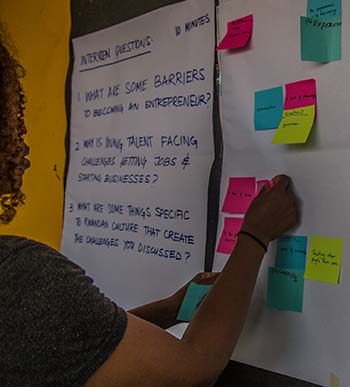
Vous disposez à présent d’une grande quantité d’idées autonomes ; il est temps de commencer à les regrouper au sein des petits groupes. Y a-t-il des idées similaires ? Regroupez-les et attribuez-leur un nom. Certains groupes pourraient-ils être combinés pour créer une “méga” idée ? Établissez des relations entre ces groupes. Cette étape offre l’occasion d’approfondir et d’ajouter des précisions à la première série d’idées.
(Crédit photo : Yagazie Emezi/Getty Images/Images of Empowerment)
Une fois vos idées un peu mieux articulées, il convient de les classer par ordre de priorité, car elles ne peuvent pas toutes être développées. L’une des méthodes préférées pour hiérarchiser les idées consiste à utiliser une simple matrice importance/difficulté, ou une matrice effort/impact.
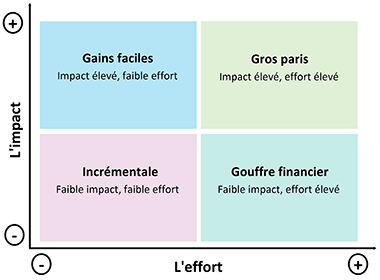
Au terme de l’idéation, vous devriez avoir au moins 2 idées fortes par petits groupes qui sont prêtes à être développées en concepts. Les exemples ci-dessous sont tirés de l’étude du cas Nourishing Connections.
L’équipe de Nourishing Connections a suivi les trois étapes de l’idéation. L’équipe a commencé par 50 idées différentes, qui se sont finalement transformées en 8 idées classées par ordre de priorité au fil de l’évolution d’une étape à l’autre, de l’idéation rapide à la combinaison et à la fusion, puis au classement par ordre de priorité.
| Questions de type « Comment pourrions-nous » → | Idéation rapide → | Combinaison et fusion → | Classer par ordre de priorité |
| 1. Comment pourrions-nous promouvoir la sensibilisation autour des denrées alimentaires saines, disponibles à l’échelle locale et peu coûteuses, tout en positionnant les aliments disponibles à l’échelle locale comme des aliments de plus grande valeur, plus souhaitables et plus adaptés aux jeunes enfants ? 2. Comment pourrions-nous renforcer les capacités des mères et des gardien(ne)s d’enfants en matière de préparation et de transformation des aliments afin de faciliter la préparation de repas sûrs, nutritifs et digestes adaptés aux enfants de 6 à 24 mois ? 3. Comment pourrions-nous alléger de façon stratégique le coût, le temps et l’énergie consacrés par les mères et les gardien(ne)s d’enfants à la préparation de repas nutritifs pour les enfants de 6 à 24 mois, et qui s’ajoute aux autres responsabilités au sein du foyer et de la communauté ? | ~50 idées | Idée 1 – Formation des ASC à la culture, à l’achat et à la préparation de denrées locales Idée 2 – Partage d’expériences culinaires en groupe Idée 3 – Sensibilisation active à l’égard des hommes afin qu’ils apportent leur appui aux mères et aux gardien(ne)s d’enfants Idée 4 – Pièce de théâtre communautaire qui présente les avantages de bien nourrir les enfants Idée 5 – Mettre à contribution les influenceurs Idée 6 – Démonstration culinaire et conseils prodigués à la radio et à travers des pièces de théâtre communautaires Idée 7 – Sensibilisation de la communauté lors d’une réunion publique locale Idée 8 – Activités de formation pour la communauté Idée 9 – Jeu pour les réunions communautaires Idée 10 – Outils pour les agents de santé communautaires Idée 11 – Activité qui permet de susciter de l’empathie entre les gardien(ne)s d’enfants et les agents de santé communautaires | Idée 1 – Une série de questions qui permettent aux agents de santé communautaires de comprendre la situation actuelle des gardien(ne)s d’enfants Idée 2 – Un outil/une activité pour susciter de l’empathie Idée 3 – Un jeu qui sert de démonstration de cuisine et qui permet de renforcer les connaissances des familles Idée 4 – Un jeu de questions et réponses Idée 5 – Une session de conseils optimisée pour guider, accélérer, améliorer, aider et orienter sur l’empathie Idée 6 – Outil de comparaison des prix Idée 7 – Brochure de conseils et d’astuces Idée 8 – Planificateur de repas hebdomadaires |
Un concept est une idée plus élaborée ou un mélange d’idées. Il va au-delà de toute idée individuelle et constitue une étape de réflexion au cours de laquelle les concepteurs cherchent à élaborer une solution plus globale (ThinkPlace Global Institute of Regenerative Design & Terry, 2022). Il contient davantage de détails qui permettent de répondre aux questions clés « qui, quoi, quand, où, pourquoi, comment ».
Retournez chaque carte pour découvrir les avantages de la formulation d’un concept.
Affinez et réduisez vos idées afin de les clarifier et de les rendre plus précises.
Procéder à l’évaluation de divers facteurs tels que la demande, la faisabilité technique, les besoins en ressources et les défis potentiels.
Affiner et adapter aux besoins des utilisateurs à travers la prise en compte des caractéristiques, des approches et une proposition de valeur innovantes.
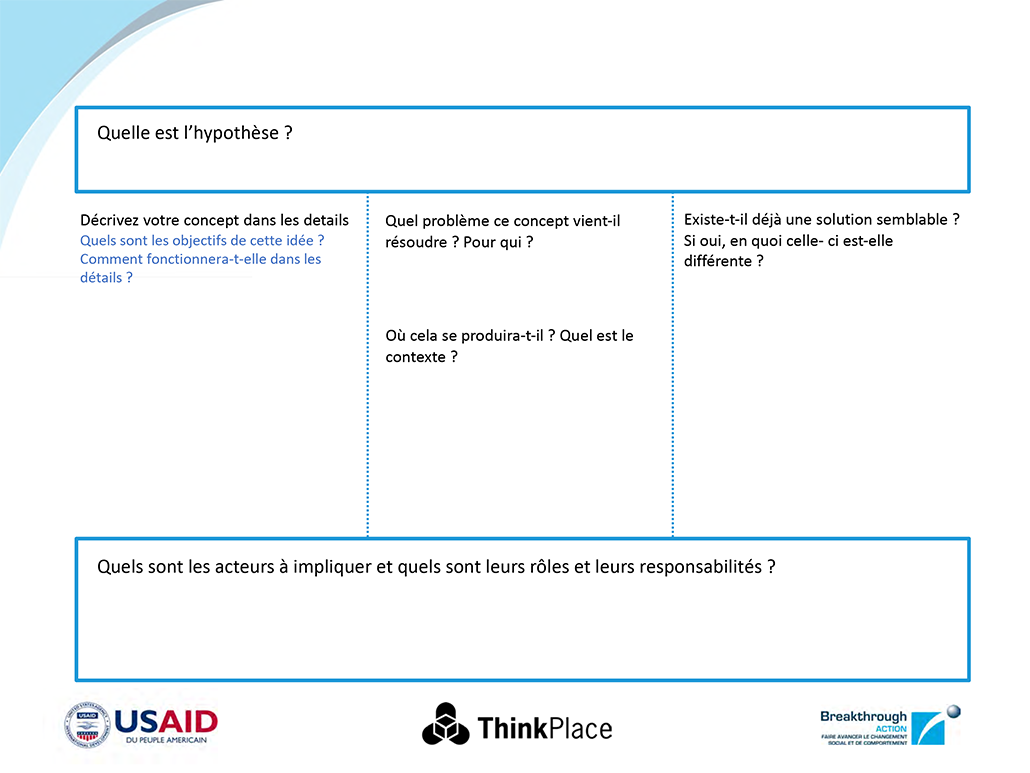
Trois exemples de concepts tirés du projet Nourishing Connections sont présentés ci- après.
Le fait d’aider les ASC à comprendre la situation actuelle des gardien(ne)s d’enfants permet aux ASC de fournir des conseils personnalisés et pertinents de manière plus efficace.
Quels sont les objectifs de cette idée ? Comment cette idée fonctionnera-t-elle dans les détails ?
Inspiré des jeux de type « choisissez votre propre aventure », dans laquelle les clients doivent sélectionner les options qui représentent le mieux leurs expériences passées, de sorte à déterminer leur situation actuelle à l’issue du jeu. Les expériences passées doivent être divisées en 3 catégories :
Il y aura une version de ce jeu adaptée aux mères/gardien(ne)s d’enfants et aux influenceurs.
Quel problème ce concept permet-il de résoudre ? Pour qui ?
Ce concept vise à remédier au manque de soins empathiques lors des séances de conseil.
Où cela se passera-t-il ? Quel en est le contexte ?
Pendant les visites à domicile ou au sein d’une structure de santé.
Existe-t-il déjà un jeu de ce type ? Si oui, en quoi celui-ci fait-il la différence ?
À notre connaissance, il n’existe rien de semblable au Nigéria.
Quels sont les acteurs à impliquer et quels doivent être leurs rôles et leurs responsabilités ?
Les superviseurs doivent apprendre à utiliser l’outil et orienter les ASC vers cet outil.
Les ASC doivent apprendre à utiliser l’outil lors des séances de conseil qu’ils organisent.
La mise en scène d’une situation dans laquelle une alimentation diversifiée est présentée, et qui s’inspire du processus de prise de décision et tient compte des contraintes de la vie quotidienne peut permettre de faciliter une meilleure compréhension et un changement d’attitude.
Quels sont les objectifs de cette idée ? Comment cette idée fonctionnera-t-elle dans les détails ?
Il s’agit d’un jeu de cartes qui permet d’éduquer les joueurs sur les repas 4 étoiles. Chaque carte présente une image d’un aliment disponible localement dans une catégorie spécifique, et une icône identifie la catégorie en question. L’objectif du jeu est de permettre aux joueurs de créer des repas 4 étoiles pour l’alimentation complémentaire au moyen des cartes, à travers la combinaison de l’une des cartes de chacune des quatre catégories existantes.
Quel problème ce concept permet-il de résoudre ? Pour qui ?
Ce concept vise à remédier au déficit de connaissances des gardien(ne)s d’enfants relativement aux différents régimes alimentaires et au manque d’espace mental pour tester de nouvelles recettes, ainsi qu’aux différents rôles que peuvent jouer les membres clés de la famille pour faciliter l’adoption d’une alimentation équilibrée pour les enfants âgés de 6 à 24 mois.
Où cela se passera-t-il ? Quel en est le contexte ?
Ce jeu peut être utilisé pendant ou en dehors des sessions de conseil menées par les ASC.
Existe-t-il déjà un jeu de ce type ? Si oui, en quoi celui-ci fait-il la différence ?
Il existe un jeu similaire, mais il ne permet pas d’y ajouter de la complexité telle que des personnages réels, de plus grandes marges d’erreurs qui suscitent la réflexion, obligent à prendre des décisions différentes et entraînent un changement d’attitude. Il n’est donc pas en mesure d’imiter la vie réelle.
Quels sont les acteurs à impliquer et quels doivent être leurs rôles et leurs responsabilités ?
Les superviseurs doivent apprendre à utiliser l’outil et orienter les ASC vers cet l’outil.
Les ASC doivent apprendre à utiliser l’outil lors des séances de conseil qu’ils organisent.
La rationalisation du protocole de conseil pour se focaliser sur la compréhension d’une situation spécifique permettra aux ASC d’apporter des conseils aux gardien(ne)s d’enfants de manière plus efficace et efficiente.
Quels sont les objectifs de cette idée ? Comment cette idée fonctionnera-t-elle dans les détails ?
Simplifier le protocole de la séance de conseils pour la rendre plus empathique et plus efficace dans l’identification des causes profondes de certains comportements.
Les ASC doivent toujours commencer par une déclaration sur les expériences passées, les mythes ou les défis courants. Après la réponse de la mère, les ASC doivent poser la question « pourquoi » au moins à trois reprises jusqu’à ce que la cause profonde soit comprise.
Quel problème ce concept permet-il de résoudre ? Pour qui ?
Ce concept vise à permettre aux ASC de :
Où cela se passera-t-il ? Quel en est le contexte ?
Pendant les visites à domicile
Existe-t-il déjà un jeu de ce type ? Si oui, en quoi celui-ci fait-il la différence ?
À notre connaissance, il n’existe rien de semblable au Nigéria.
Quels sont les acteurs à impliquer et quels doivent être leurs rôles et leurs responsabilités ?
Les superviseurs doivent apprendre à utiliser l’outil et orienter les ASC vers cet outil.
Les ASC doivent apprendre à utiliser l’outil lors des séances de conseil qu’ils organisent.

Merci d’avoir suivi la quatrième leçon de l’ouvrage Mettre en pratique la conception centrée sur l’humain pour l’amélioration des programmes de nutrition. Vous trouverez ci-dessous un questionnaire non noté qui vous permettra de vérifier votre compréhension de de la session 4. Cliquez sur le bouton « Contrôle des connaissances » pour commencer.
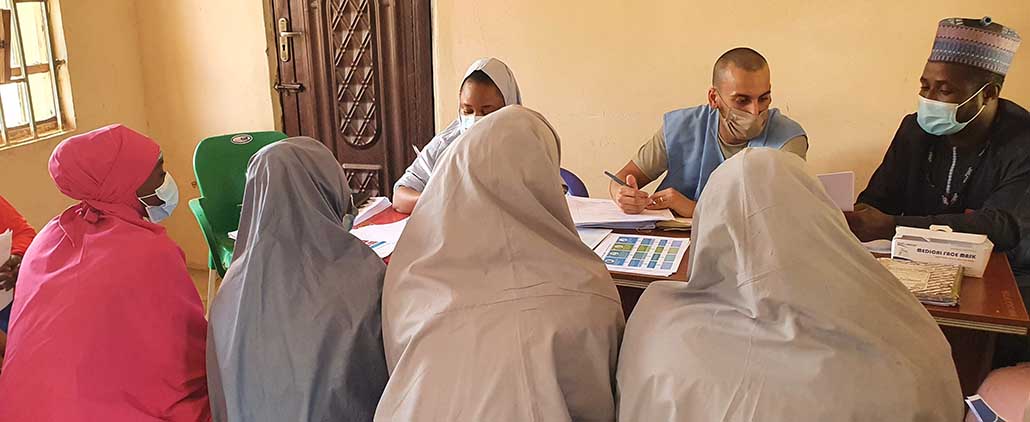
Merci d’avoir suivi la troisième leçon de l’ouvrage Mettre en pratique la conception centrée sur l’humain pour l’amélioration des programmes de nutrition. Vous trouverez ci-dessous un questionnaire non noté qui vous permettra de vérifier votre compréhension de de la session 3. Cliquez sur le bouton « Contrôle des connaissances » pour commencer.